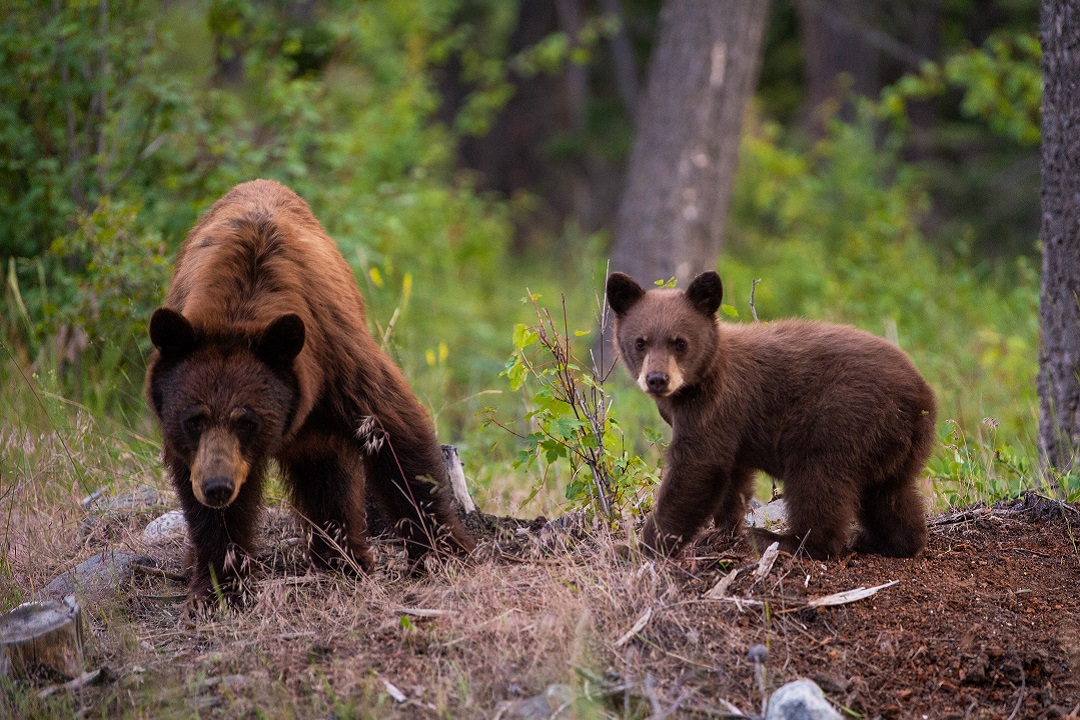Imagine running on a steep trail in the woods, watching your feet to avoid tripping on a rock. You happen to glance up and suddenly, a bear is on the path 20 yards in front of you.
What would you do? Panic? Run away? Shout? Do you know what you should do?
This was the scenario for Jonathan Murphy during a trail run this past May in Busiek State Park, near Springfield, Missouri.
“My first thought was ‘Oh no, somebody’s dog got loose.’ Then I was thinking ‘That’s a funny-looking dog.’ It turned around and looked at me. I saw the brown on the nose and could see the shape of it better,” he said.
That’s when Murphy realized it was a bear. Fortunately, he knew what to do.
“We just kind of looked at each other for five seconds, then I started backing up and he took off. I kept my distance,” he said.
This was Murphy’s first bear sighting, other than from a car on one of his many trips to Colorado and Wyoming. He said the animal was the size of an adult sheep — maybe 250 pounds. He’s able to make this estimate because he grew up on a sheep farm.
“I was very surprised,” said Murphy, of Nixa, Missouri. “I never thought I’d see a bear in Missouri.”
But the black bear population in Missouri is on the rise, making encounters with bears more common. Local media reported on numerous black bear sightings in the St. Louis region this past spring and summer. People are snapping photos and capturing video of the furry animals ambling across backyards and driveways, overturning trash cans and raiding bird feeders.
A bear spotted in Glendale in May made its way through Webster Groves, Brentwood, and Richmond Heights before personnel from the Missouri Department of Conservation (MDC) tranquilized the animal and relocated it to the countryside.
Laura Conlee, furbearer and black bear biologist at MDC, said Missouri’s black bear population is growing about 9 percent per year. In 2012, the group estimated there were 300 in the state; this year they believe the number has grown to 800. To prevent overpopulation, MDC is organizing a one-week hunting season in October. This will be the first time Missouri will allow bears to be hunted, and only 40 bears can be killed statewide.
She said bears mostly reside in the southern third of the state, preferring forested areas and generally staying south of Interstate 44. A number of sightings have occurred at the Lake of the Ozarks.
“From May through July, we tend to see the most bear reports,” Conlee said. “Many are young males, one and a half to three years old. They tend to cover large distances but they’re not necessarily of breeding age yet.”
Are Black Bears Dangerous?
Most people have some trepidation about bears. Grizzlies have a reputation for attacking humans, but black bears do not.
“It’s important to know that we’ve never had a bear attack on a human in Missouri [in modern times], but they are wild animals, so people need to be bear aware,” Conlee said. “Missouri is bear country, but it’s new for many people. The reality is we have this growing bear population. They can show up anywhere.”
Safety Tips
Conlee shared her top safety tips. More information can be found at mdc.mo.gov/bears.
When camping:
- Food and trash should be stored in a bear-proof container, your car, or secured by hanging it between two trees.
- Never store food or scented items like deodorant and toothpaste in your tent.
- Do your cooking in a separate area from your tent.
- If you see a bear getting into your food, get to a safe location and clap your hands and yell. Tell others that you saw a bear and remind them not to leave food out.
When hiking:
- If you see a bear, raise your hands over your head to make yourself look bigger. Kids can do this as well as adults.
- Back away, don’t run. Speak to the bear in a calm voice.
- If you purchase bear spray to use in the event you are attacked, make sure you know how to use it. See online videos to educate yourself.
In your neighborhood:
- Make sure no food sources are in your yard from May through July, when young males tend to roam the most. Common culprits are pet food, bird feeders, chicken feed, and beehives. Electric fence can be set up to protect beehives and chicken coops.
- Bang pots and pans and yell at the bear to give it the message that it isn’t welcome.
Black bears come in different colors, including light brown, blondish, cinnamon brown, chocolate brown, and jet black. Never feed a black bear or other bears, otherwise they will come back for more, and could cause a dangerous situation, putting them at risk of being euthanized. As Conlee often preaches: A fed bear is a dead bear.
Also, seeing a bear “is not an opportunity for pictures or calling over your friends. Back out of the area and let the bear be. It doesn’t like the situation,” Conlee said.
Tracking Missouri’s Bears
MDC began measuring reproductive and survival rates of female bears in Missouri in 2010. The department is also measuring black bear habitat use and movement patterns. That data is used to help prioritize areas for targeted outreach and education.
Since the project began, MDC has marked more than 200 black bears and has placed collars on over 100 of them.
If you see a bear, MDC encourages you to report where you spotted it. Visit mdc.mo.gov/reportbears to report the sighting. If you’re at a safe distance to take a photo, you can upload it to the site.
Author: Terri Waters is a regular contributor to Terrain Magazine.


Leave A Comment